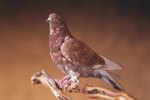Many different types of birds can suffer from a condition commonly known as splayed legs or spraddle. If your bird is suffering from splayed legs, he will be unable to stand up straight on his legs because his legs will go out to the sides of his body. Birds with severely splayed legs may be completely unable to walk. The severity of a bird's condition determines your ability to help straighten his legs.
Causes of Splayed Legs
Most birds develop splayed legs while they are still in the nest. The condition can be the result of poor nutrition, missing bedding, inappropriate bedding or a nest surface that is too slick for the bird's feet to grasp. Legs that do not develop adequately are not strong enough to support the bird's weight. The bones in the legs wind up distorting, bending sideways rather than allowing the bird to stand up straight.
Severity of Condition
The expertise of a qualified veterinarian, avian expert or wildlife rehabilitation specialist is essential if you want to correct a bird's splayed legs. The combination of the age of the bird and the severity of the condition will determine exactly how treatable the bird's condition is. A younger bird stands a better chance of correction than an adult bird does, though some adult birds do benefit from treatment. An affected bird's legs may never be completely straight; treatment is considered successful if a bird achieves a semi-normal level of mobility. A bird with severely splayed legs is immobile and will suffer from additional health problems as a result of being unable to walk or stand.
Treatment Methods
The treatment for a bird with splayed legs involves gradually bringing the legs back under the bird. Most treatment methods involve designed a shackle-type device that attaches the legs to one another with some slack in the center to allow for movement. The device is gradually tightened in the center until the legs are brought back into a normal position. The treatment takes days to perform, small amounts of progress occurring over time until the legs are strong enough to support the bird in a normal fashion. The cuffs of the device -- the parts that fasten around the leg -- must be loose enough to allow for proper circulation while maintaining pressure. In severe cases of spraddle, a veterinarian may opt to perform surgery to correct and reshape the bones in the leg into a proper position.
Managing the Splayed-Leg Bird
The primary issue for splayed-leg birds is mobility. A bird who cannot stand or move around on his own may not be able to eat or use the bathroom properly, and may be completely at risk of any predators nearby. If you own a bird with splayed legs, it is your job to make sure he can adequately feed and care for himself and to protect him from predators. Splayed-leg birds often need their toenails trimmed more often than unaffected birds and may require additional perches or modifications in their cages to help them get around.
References
Writer Bio
Jen Davis has been writing since 2004. She has served as a newspaper reporter and her freelance articles have appeared in magazines such as "Horses Incorporated," "The Paisley Pony" and "Alabama Living." Davis earned her Bachelor of Arts in communication with a concentration in journalism from Berry College in Rome, Ga.





